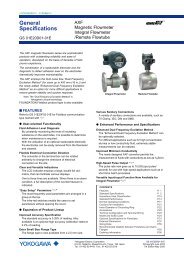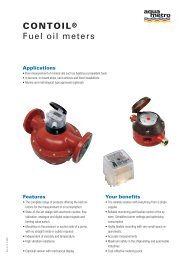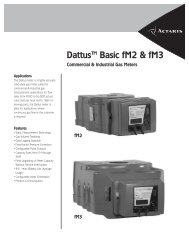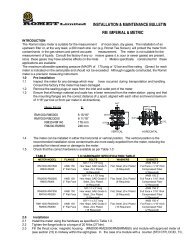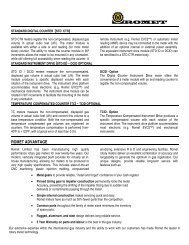User's Manual AXF Magnetic Flowmeter Integral ... - Yokogawa
User's Manual AXF Magnetic Flowmeter Integral ... - Yokogawa
User's Manual AXF Magnetic Flowmeter Integral ... - Yokogawa
You also want an ePaper? Increase the reach of your titles
YUMPU automatically turns print PDFs into web optimized ePapers that Google loves.
4. WIRING<br />
Connect the <strong>AXF</strong> integral flowmeter terminal to<br />
external instruments, giving attention to the following<br />
points.<br />
For FOUNDATION Fieldbus protocol, please refer to<br />
IM 01E20F02-01E.<br />
4 to 20 mA DC Current Output<br />
NOTE<br />
For pulse output from the DO terminals, parameters<br />
must be set. Refer to “Parameter Description”<br />
in the user’s manual of the <strong>AXF</strong> <strong>Integral</strong><br />
<strong>Flowmeter</strong> [Software Edition] (IM 01E20C02-<br />
01E).<br />
<strong>AXF</strong> integral flowmeter<br />
l+<br />
l-<br />
Receiver<br />
Instrument<br />
Resistive load max. 750 Ω.<br />
(When using BRAIN/ HART communication,<br />
more than 250 Ω, less than 600 Ω).<br />
Figure 4.1.10 4 to 20 mA DC Output Connection<br />
F0411.EPS<br />
Protective diode<br />
Mechanical Counter<br />
Load Electronic Counter<br />
30V DC, 0.2A. max<br />
F0412.EPS<br />
Pulse Output<br />
Figure 4.1.11 Pulse Output Connection<br />
IMPORTANT<br />
• As this is a transistor contact (insulated type),<br />
give attention to proper voltage and polarity<br />
when wiring.<br />
• Do not apply a voltage larger than 30V DC or a<br />
current larger than 0.2A in order to prevent<br />
damage to the instrument.<br />
• When input filter constant of the electronic<br />
counter is large in relation to the pulse width,<br />
the signal will decrease and the count will not<br />
be accurate.<br />
• If the input impedance of the electronic counter<br />
is large, an induction noise from the power<br />
supply may result in inaccurate counts. Use a<br />
shield cable or sufficiently reduce the input<br />
impedance of the electronic counter within the<br />
electromagnetic flowmeter pulse output specification<br />
range.<br />
• The active pulse output (Optional code EM)<br />
cannot be used in conjunction with the standard<br />
pulse output.<br />
• When the active pulse output (Optional code<br />
EM) is selected, do not be short-circuit between<br />
the DO+ and DO– terminals to avoid damaging<br />
the instrument.<br />
• When the active pulse output (Optional code<br />
EM) is selected, the range of pulse rate must<br />
be set to 2 pps maximum.<br />
• To avoid communication (BRAIN/ HART)<br />
failure, it is recommended to use the shield<br />
cable.<br />
<strong>AXF</strong> integral flowmeter<br />
DO+<br />
PULSE OUT<br />
PULSE OUT<br />
<strong>AXF</strong> integral flowmeter DO+<br />
<strong>AXF</strong> integral flowmeter DO+<br />
PULSE OUT<br />
DO-<br />
<strong>AXF</strong> integral flowmeter DO+<br />
PULSE OUT<br />
DO-<br />
DO-<br />
DO-<br />
Load<br />
Output voltage: 24 V DC 20%<br />
• Current: 30 to 150 mA<br />
Pulse rate: 0.0001 to 2 pps<br />
Pulse width: 20, 33, 50, 100 ms<br />
Protective diode<br />
Mechanical Counter<br />
Electronic Counter<br />
Figure 4.1.12 Active Pulse Output (Optional code EM)<br />
F0413.EPS<br />
4-6<br />
IM 01E20D01-01E






